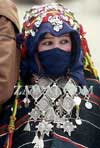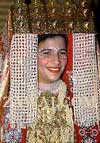
HOME
WEDDING
CUSTOMS
MOROCCAN WEDDINGS
MOROCCAN WEDDINGS
In some parts of Morocco, tradition requires that five days before
the wedding, the bride has a ceremonial bath, then is painted
with henna swirls on hands and feet, an adorned with makeup and
jewels by other women. For centuries, elaborate henna has been
applied to Moroccan brides. The night before the wedding, the
bride and other women gather together for the henna ritual. The
bride receives the most elaborate designs, while the other women
are often patterned with lesser designs, covering only small
portions of the body. Within the bride's henna design is often
found the name of the groom. Further, a bride is not expected
to perform any housework until her henna has faded. The wedding
henna ritual has a deeper purpose than mere aesthetic beauty.
During the evening of the "henna party," the older,
married women share the secrets of marriage with the bride-to-be.
Moroccan women continue the tradition to this day. However, there
are some women in Morocco who refuse to wear henna in an effort
to move in a more "modern" direction. This is not to
say that women with henna are not "modern," but rather
demonstrating the various views of henna within the Moroccan
context.
Before becoming guardian of her hearth, the Moroccan bride circles
her marriage home three times.
|
In some parts of Morocco, tradition requires that five days before
the wedding, the bride has a ceremonial bath, then is painted
with henna swirls on hands and feet, an adorned with makeup and
jewels by other women. For centuries, elaborate henna has been
applied to Moroccan brides. The night before the wedding, the
bride and other women gather together for the henna ritual. The
bride receives the most elaborate designs, while the other women
are often patterned with lesser designs, covering only small
portions of the body. Within the bride's henna design is often
found the name of the groom. Further, a bride is not expected
to perform any housework until her henna has faded. The wedding
henna ritual has a deeper purpose than mere aesthetic beauty.
During the evening of the "henna party," the older,
married women share the secrets of marriage with the bride-to-be.
Moroccan women continue the tradition to this day. However, there
are some women in Morocco who refuse to wear henna in an effort
to move in a more "modern" direction. This is not to
say that women with henna are not "modern," but rather
demonstrating the various views of henna within the Moroccan
context. Before becoming guardian of her hearth, the Moroccan bride circles her marriage home three times. |
 BACK
TO WEDDING CUSTOMS
BACK
TO WEDDING CUSTOMS
|











